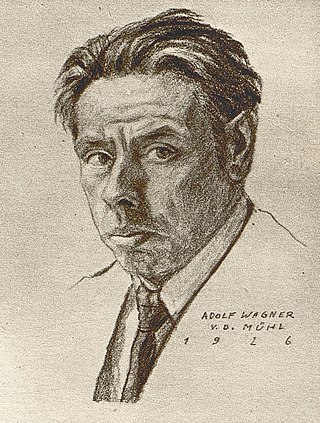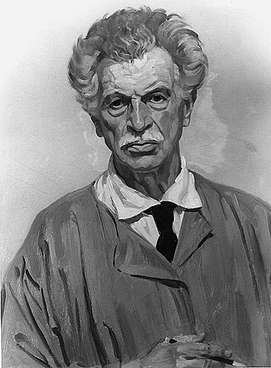Biography
His father was a master carpenter. He spent three years as an apprentice at his father's company, painting furniture, signs and crosses. Encouraged by the lithographer and art dealer, Josef Hafner, he enrolled at the Academy of Fine Arts, Vienna. His teachers there included Leopold Kupelwieser and Thomas Ender. After 1830, he largely earned his living as a porcelain painter.
Probably as the result of a recommendation by Kupelweiser, he was awarded a scholarship by the Upper Austrian Landstand that enabled him to continue his studies from 1834 to 1837. During this time, he also exhibited and won the Lampi-Preis for model drawing in 1836. He was married in 1839. Originally, he did genre and historical scenes, but he decided to switch to portraits and soon became so popular that he was able to purchase a large house in Vienna with a four-horse carriage and a Moor as a servant.
During the Revolution of 1848 he sided with the revolutionaries. Possibly due to the trouble this caused, his wife left him in 1850. From then until 1870, he was a regular participant at the exhibitions of numerous Austrian art societies.
It is unclear if he was divorced or his first wife died, but he was remarried in 1866. His new wife's extravagance eventually forced him to take more orders than he could handle, as well as turn to making copies of the Old Masters. She died in 1889, and he died the following year. He was interred at the Zentralfriedhof.
In 2013, a major retrospective was jointly hosted by the Schlossmuseum Linz [ de ] and the Nordico Stadtmuseum [ de ]. It included over 170 works gathered from museums in Vienna and Budapest and private collections. [1]

Egon Leo Adolf Ludwig Schiele was an Austrian Expressionist painter. His work is noted for its intensity and its raw sexuality, and for the many self-portraits the artist produced, including nude self-portraits. The twisted body shapes and the expressive line that characterize Schiele's paintings and drawings mark the artist as an early exponent of Expressionism. Gustav Klimt, a figurative painter of the early 20th century, was a mentor to Schiele.

Ferdinand Georg Waldmüller was an Austrian painter and writer. Waldmüller was one of the most important Austrian painters of the Biedermeier period.

Aloys Wach or Aloys Ludwig Wachelmayr was an Austrian expressionist painter and graphic artist. He was born in Lambach, Upper Austria, and died in Braunau, Upper Austria. While his birthplaces him close to the generation that laid the foundations of modern art and especially expressionism, his life as an artist, however, began after cubism, futurism and the expressionists of the Der Blaue Reiter and Die Brücke movements had initiated a time of great changes. In his later life, Wach abandoned his artistic roots and distanced himself from his early expressionist works by turning to religious imagery. Today, however, those early works are seen as his greatest accomplishments.

Johann Peter Krafft was a German-born Austrian painter who specialized in portraits, historical works, and genre scenes.

Johann Baptist von Lampi the Younger was an Austrian portrait painter.

Josef Theodor Moroder, also known as the Lusenberger, was a painter and sculptor, the most prominent artist of the Moroder family from the Grödenthal in South Tyrol.
Fritz Aigner was an Austrian graphic artist and painter.

Josef Danhauser was an Austrian painter and one of the prominent artists of Biedermeier period, along with Ferdinand Georg Waldmüller, Peter Fendi, and others. Danhauser's works, which went largely unappreciated in his time, dealt with moralising subjects and had a clear influence of William Hogarth.

Franz Eybl was an Austrian painter.

Hans Canon was the pseudonym of Johann Baptist Strašiřipka, an Austrian history and portrait painter.

Franz Rumpler was an Austrian genre and landscape painter.

Maximilian Albert Josef Liebenwein was an Austrian-German painter, graphic artist and book illustrator, in the Impressionist and Art Nouveau styles. He spent significant time in Vienna, Munich and Burghausen, Altötting, and took an active part in the artistic community in all three places. He was an important member of the Vienna Secession, becoming its vice-president, and exhibiting with the group many times.

Ludwig Johann Passini (1832–1903) was an Austrian narrative and genre painter and printmaker.

Johann Baptist Pflug was a German genre painter.

Johann Victor Krämer was an Austrian painter and photographer, working generally within the Orientalist genre. He was a founding member of the Vienna Secession, and received many awards through his life.

Adolf Wagner von der Mühl was an Austrian sculptor.

Ferdinand Andri was an Austrian architect. His work was part of the architecture event in the art competition at the 1936 Summer Olympics.

Ferdinand Brunner was an Austrian landscape painter.

Johann Baptist Kirner was a German portrait and genre painter.
Wieland der Schmied is the unfinished juvenilia opera by Adolf Hitler that he began around 1905, in his early 20s.
This page is based on this
Wikipedia article Text is available under the
CC BY-SA 4.0 license; additional terms may apply.
Images, videos and audio are available under their respective licenses.



















